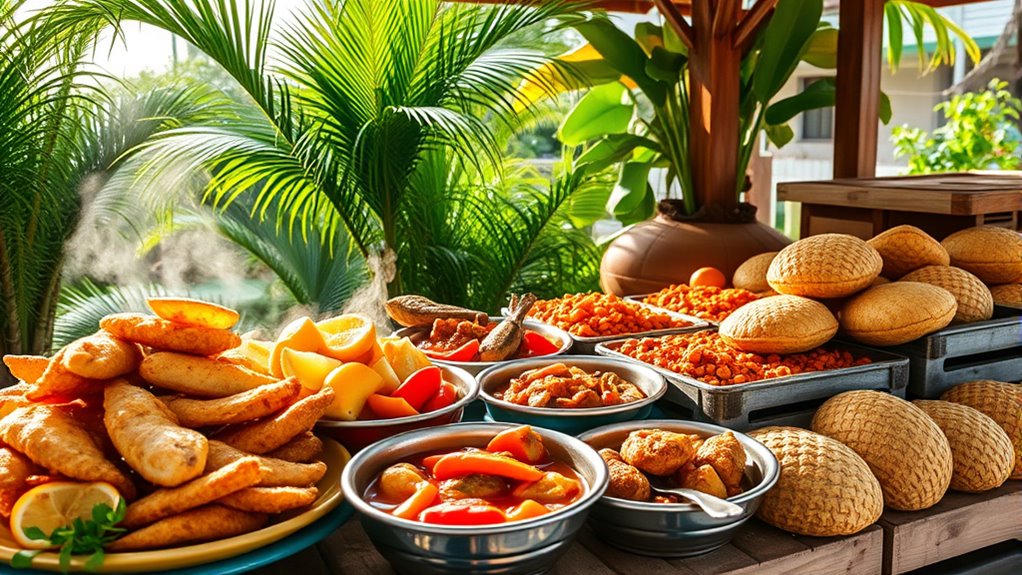Discover the vibrant culinary traditions of the Cayman Islands, where indigenous ingredients like seafood, yams, and tropical fruits blend with Caribbean, African, and European influences. You’ll find iconic dishes such as conch stew, turtle stew, and Cayman-style beef, cooked with local techniques like stewing and frying. Festivals and community events celebrate these flavors, preserving cultural heritage. To explore how these traditions continue evolving today, keep exploring what makes Cayman cuisine unique.
Key Takeaways
- Caymanian cuisine is a fusion of indigenous resources, British, and African influences, emphasizing seafood, root vegetables, and tropical fruits.
- Traditional dishes like conch stew, turtle stew, and Cayman-style beef are central to cultural celebrations and community gatherings.
- Cooking techniques include stewing, frying, marinating, and coconut milk-based preparations, preserving authentic flavors and customs.
- Festivals such as Fish Fry and Cayfest showcase local foods, strengthening cultural identity and passing culinary traditions to new generations.
- Modern practices focus on sustainability, responsible fishing, and incorporating contemporary culinary methods to preserve Cayman’s food heritage.
The Roots of Caymanian Culinary Heritage
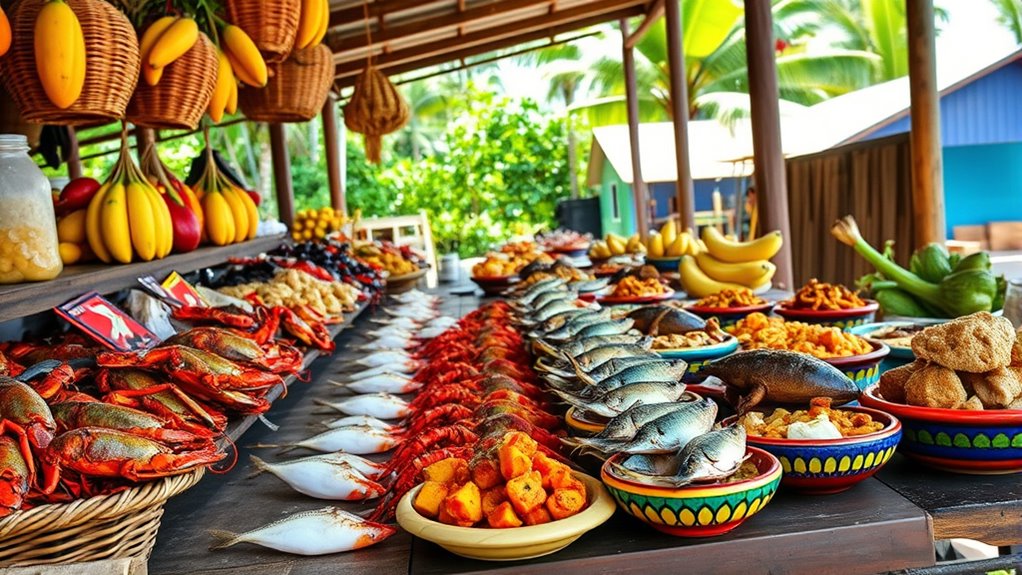
The roots of Caymanian culinary heritage run deep in the islands’ history, shaped by the resources available and the diverse peoples who settled there. You’ll find that early Caymanians relied heavily on local seafood, root vegetables like yams and cassava, and tropical fruits such as mangoes and papayas. When settlers from Britain and Africa arrived between the 17th and 18th centuries, they introduced new cooking practices and dishes, blending European and African flavors with indigenous ingredients. British influences brought meat pies and turtle stew, while African traditions contributed coconut milk-based stews like rundown. Over centuries, these diverse influences fused into a unique culinary identity, reflecting the islands’ multicultural roots and the resourcefulness of its people. Additionally, the incorporation of fermentation techniques has played a role in preserving local produce and enriching traditional flavors.
Iconic Dishes That Define Cayman Cuisine
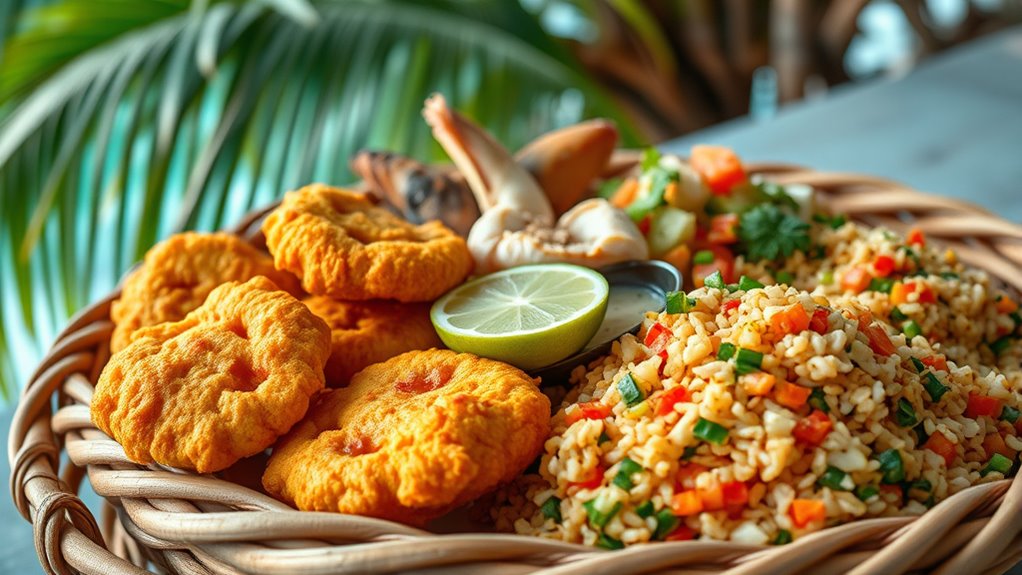
Iconic dishes in Cayman cuisine showcase the rich tapestry of flavors and traditions that have shaped the islands’ culinary identity. You’ll find conch stew, a flavorful mix of locally harvested conch, vegetables, and spices, often served at family gatherings and festivals. Turtle stew, once a staple, reflects the colonial seafaring history, combining turtle meat with roots and spices. The vibrant Fish Fry features freshly caught fish, battered or fried, paired with sides like plantains and coleslaw, emphasizing community spirit. Marinated conch salad offers a tangy, fresh bite with lime, onions, and peppers. Cayman-style beef, slow-cooked with spices, is a festive favorite. These dishes embody the islands’ love for seafood, bold flavors, and cultural heritage, making Cayman cuisine uniquely authentic.
Key Ingredients and Local Harvests

You’ll find that Cayman Islands cuisine relies heavily on its coastal seafood bounty, with reef fish, conch, and lobster taking center stage. Tropical fruits like mangoes and papayas, along with root vegetables such as yams and cassava, provide essential flavors and nutrients to local dishes. These fresh, local harvests shape the vibrant and authentic character of Cayman’s culinary traditions. Incorporating local food preservation methods ensures that these ingredients remain available year-round, enhancing the diversity of the cuisine.
Coastal Seafood Bounty
Cayman Islands’ culinary landscape is deeply rooted in its abundant coastal waters, which provide a rich array of fresh seafood. You’ll find reef fish like snapper and grouper, prized for their firm texture and clean flavor. Conch, harvested daily, features prominently in stews, salads, and fritters, showcasing its versatility. Lobster, caught seasonally, is a delicacy often served grilled or boiled. Locals also rely on sea turtles historically, though their numbers now decline due to conservation efforts. Shellfish such as crabs and scallops add variety to dishes. These seafood sources are complemented by seasonal catches, ensuring dishes remain fresh and vibrant. The island’s connection to its waters fosters a culinary tradition centered on sustainable harvesting and celebrating the bounty of the sea. Additionally, seafood sustainability is a growing focus to preserve these vital marine resources for future generations.
Tropical Fruits and Roots
The rich variety of seafood is complemented by a vibrant array of tropical fruits and root vegetables that form the backbone of Caymanian cuisine. You’ll find mangoes, papayas, and breadfruit, which add sweetness and texture to many dishes. Root vegetables like yams, cassava, and sweet potatoes are essential staples, often mashed or boiled to serve alongside seafood or meats. These ingredients aren’t just food—they’re part of the island’s cultural identity, harvested locally and celebrated in traditional recipes. Scotch bonnet peppers bring heat and flavor, while coconut milk, extracted from coconuts, enriches stews and rice dishes, reflecting African and Caribbean influences. Together, these tropical fruits and roots create the vibrant flavors that define Cayman’s culinary heritage.
Traditional Cooking Techniques and Flavors

Traditional Caymanian cooking techniques focus on slow, flavorful processes that highlight fresh ingredients and regional spices. You’ll find stewing as a common method, where seafood and meats simmer gently with coconut milk, vegetables, and herbs, creating rich, tender dishes. Frying is also popular, especially for community gatherings like fish fries, where fish or seafood is battered or breaded before frying to enhance flavor and texture. Marinating seafood, such as conch or fish, emphasizes freshness and adds a tangy, spicy kick, often using lime juice, onions, and scotch bonnet peppers. Spices are used carefully to enhance natural tastes without overpowering them, and vibrant colors from herbs and vegetables add visual appeal. These techniques celebrate simplicity and the island’s abundant, fresh ingredients. Fresh ingredients are central to Caymanian cuisine, reflecting the island’s rich natural resources and commitment to sustainable practices.
Celebrations and Food Cultural Significance
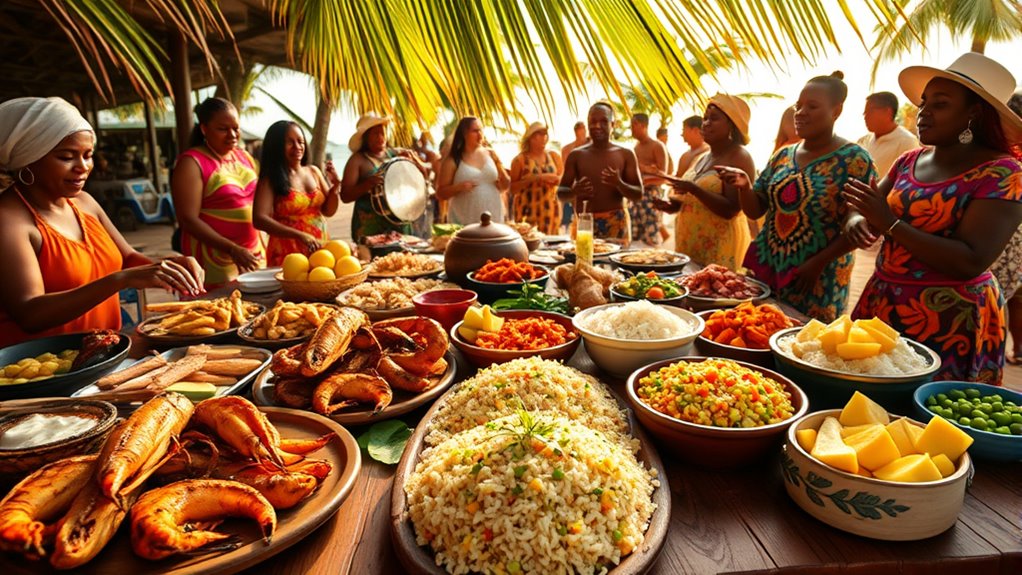
During Cayman celebrations, food takes center stage, symbolizing cultural identity and community bonds. Traditional dishes like turtle stew and fish fry are more than just meals—they represent shared history and festive spirit. These culinary traditions reinforce the significance of food in marking special occasions and preserving heritage. Vetted – Halloween Product Reviews also highlight the importance of themed costumes and celebrations that bring communities together during festive times.
Festive Dish Traditions
Festive dish traditions in the Cayman Islands play a vital role in celebrating cultural identity and community spirit. During major holidays like Constitution Day, Discovery Day, and Christmas, you’ll find traditional dishes front and center at gatherings. Fish fry events showcase freshly caught fish, battered and fried, creating a lively atmosphere that unites locals. Cayman-style beef, shredded and spiced, is often served with bread and sweet cakes, symbolizing festive cheer. Conch stew and marinated conch salads highlight the island’s seafood heritage, enjoyed with friends and family. These dishes aren’t just about flavor—they embody history, resilience, and shared pride. Preparing and sharing these foods keeps Cayman’s culinary legacy alive, strengthening bonds and passing traditions to new generations. Incorporating traditional ingredients into festive meals further enhances the cultural significance of these dishes.
Cultural Significance of Food
Food in the Cayman Islands goes beyond sustenance; it serves as a powerful symbol of cultural identity and community unity. During celebrations like Discovery Day and Christmas, traditional dishes bring people together, honoring history and heritage. Food reflects the multicultural influences—Caribbean, African, European—and connects generations through shared recipes and customs. Festivals such as Fish Fry and Pirates Week showcase lively food traditions that strengthen social bonds. These events preserve Caymanian identity and pride, emphasizing the importance of culinary heritage. The table below highlights key aspects of Cayman food’s cultural significance:
| Aspect | Example |
|---|---|
| Celebratory Dishes | Turtle Stew, Cayman-style Beef |
| Community Gatherings | Fish Fry, Cayfest |
| Heritage Preservation | Traditional recipes passed down |
| Cultural Identity | Food as a symbol of unity |
Additionally, the preservation of traditional culinary techniques plays a vital role in maintaining cultural authenticity across generations.
The Evolution of Cayman Gastronomy in Modern Times

In recent years, Cayman gastronomy has experienced a dynamic transformation as traditional recipes blend with contemporary culinary techniques. You’ll notice chefs putting a modern twist on classic dishes like conch stew and Cayman-style beef, elevating flavors with innovative ingredients and presentation. Restaurants now incorporate global influences, merging Caribbean spices with international methods such as grilling, sous-vide, and plating artistry. Local ingredients remain central, but there’s increased emphasis on sustainable seafood practices and farm-to-table concepts, supporting island agriculture. You might also find fusion dishes that honor heritage while appealing to diverse palates, reflecting Cayman’s multicultural identity. This evolution preserves core flavors but introduces exciting new dimensions, making Cayman cuisine both rooted in tradition and vibrant with modern creativity, appealing to locals and visitors alike. Additionally, some chefs experiment with candle techniques to enhance dining experiences, combining ambiance and culinary presentation to create memorable meals.
Preserving Heritage Through Festivals and Community Events
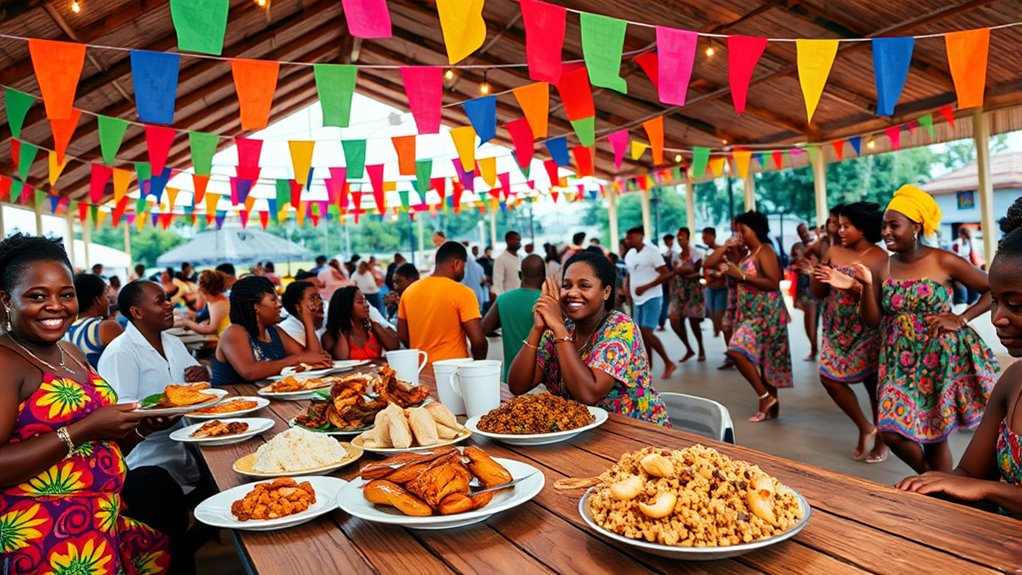
As Cayman’s culinary scene evolves with modern influences, community events and festivals play a vital role in safeguarding traditional recipes and cooking practices. These gatherings, like the Fish Fry and Pirates Week, celebrate Cayman’s food heritage, bringing locals and visitors together. They showcase signature dishes such as conch stew, turtle stew, and Cayman-style beef, ensuring these recipes are passed down through generations. Participating in these events helps you connect with Cayman’s history and culture while enjoying authentic flavors. Embracing these traditions can also inspire cultural preservation and foster community pride.
The Future of Cayman Cuisine and Sustainable Practices

The future of Cayman cuisine hinges on embracing sustainable practices that protect its rich culinary heritage and natural resources. You can play a role by supporting local fisheries that prioritize responsible harvesting, ensuring seafood remains abundant. Chefs and restaurants are adopting eco-friendly techniques, like reducing waste and sourcing ingredients locally to cut down on carbon footprints. Preserving traditional recipes while innovating with sustainable ingredients keeps Cayman’s culinary identity alive. Education initiatives are raising awareness about protecting species like sea turtles and promoting alternative protein sources. Your participation in community events and festivals helps sustain cultural practices. Additionally, promoting sustainable ingredients such as locally grown fruits and vegetables can significantly impact environmental conservation efforts. By valuing local produce and supporting sustainable tourism, you contribute to a future where Cayman cuisine continues to thrive, honoring its past and securing its natural environment.
Frequently Asked Questions
How Has Tourism Influenced Contemporary Caymanian Cuisine?
Tourism has greatly influenced your contemporary Caymanian cuisine by encouraging chefs to blend traditional flavors with international techniques, appealing to diverse palates. You’ll notice a focus on iconic dishes like conch stew and Cayman-style beef, often presented with modern flair. Resorts and restaurants also incorporate local ingredients and promote food festivals, helping preserve heritage while attracting visitors enthusiastic to experience authentic Cayman flavors in innovative ways.
Are Traditional Cayman Dishes Adapting to Modern Dietary Trends?
You’ll find that traditional Cayman dishes are adapting to modern dietary trends. Chefs now incorporate plant-based ingredients, reduce salt, and use healthier cooking methods like grilling and steaming. Some recipes substitute seafood with sustainable options or add gluten-free and vegan variations to appeal to diverse diets. This evolution respects heritage while embracing health-conscious choices, ensuring Cayman cuisine stays relevant and accessible without losing its rich cultural roots.
What Role Do Local Farmers Play in Cayman’s Culinary Scene?
Local farmers play a crucial role in Cayman’s culinary scene by providing fresh, seasonal produce like fruits, vegetables, and herbs that form the foundation of many dishes. You rely on their offerings to create authentic flavors, from tropical fruits to root vegetables. Their sustainable practices help preserve island traditions, support local economies, and guarantee that Cayman cuisine remains vibrant, fresh, and deeply connected to the land and cultural heritage.
How Is Cayman Cuisine Being Promoted Internationally?
Imagine your favorite food blog going viral—Cayman cuisine is doing just that internationally. You’ll see local dishes like conch stew and Cayman-style beef featured in global restaurants and food festivals. Chefs incorporate traditional ingredients and techniques, blending authentic flavors with modern flair. Social media campaigns, culinary festivals, and travel shows highlight Cayman’s rich seafood and vibrant culinary heritage, making its unique flavors accessible and appealing worldwide.
What Are the Challenges in Preserving Traditional Recipes Today?
You face challenges in preserving traditional recipes because modernization and global influences encourage experimentation and adaptation that can dilute authenticity. Limited access to some ingredients like turtle meat due to conservation efforts also restricts traditional dishes. Additionally, younger generations may not learn recipes from elders, risking knowledge loss. To keep Caymanian culinary heritage alive, you need to actively pass down recipes, support local ingredients, and promote awareness of cultural significance.
Conclusion
As you explore Cayman’s vibrant culinary tapestry, you become part of a living story woven with tradition and passion. Each bite is a brushstroke on the island’s rich cultural canvas, whispering tales of heritage and hope. Embrace these flavors as treasures passed down through generations, ensuring they flourish like blooming coral reefs. Your appreciation helps keep Cayman’s culinary spirit alive, a fiery beacon guiding future tastes and stories yet to be told.

